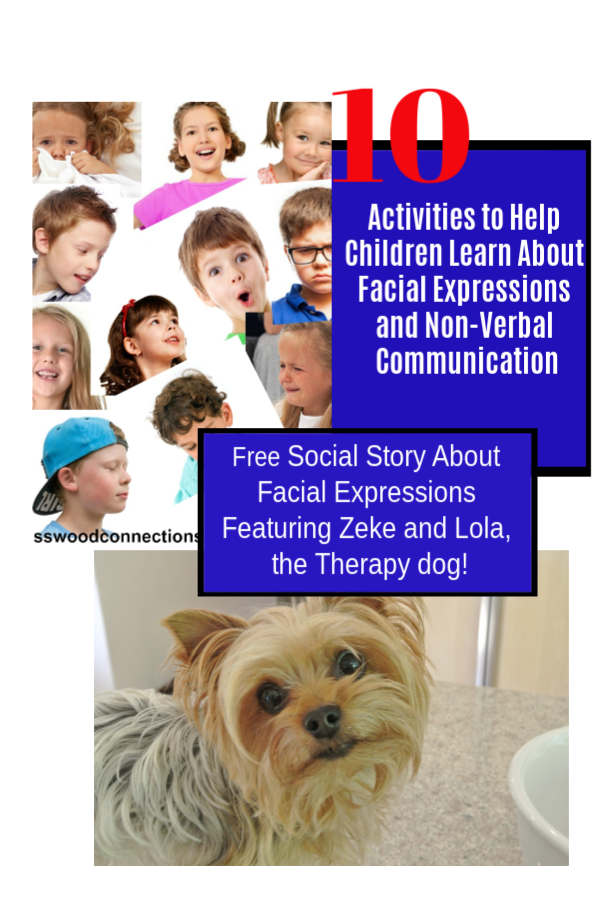Zeke Learns About Facial Expressions
Social Skills
I think your whole life shows in your face and you should be proud of that. ~Lauren Bacall
One day I was talking with Marcia Goldman author of the Lola, the Therapy Dog books and she was telling me about her dogs, Lola and Zeke. She was describing to me how expressive Lola’s face is and how Zeke has pretty much just one expression. That’s why Lola is the star. ![]()
Since Marcia is also an autism specialist I pointed out how Lola could help children learn about facial expressions and what they mean. I said that would make a great social skills book; a book that would explain facial expressions and their importance to kids. Just a few days later she sent me this as a birthday gift. What a good friend!
This page contains affiliate links. Please visit our disclosure page for more information.

ZEKE LEARNS ABOUT FACIAL EXPRESSIONS; an engaging social skills book
Communication is so much more than words. We get far more information from non-verbal cues such as body language and facial expressions. For young children, children with Attention Deficits, Sensory Processing Disorders, and Autism, recognizing this subtle form of communicating may not come naturally so we need to help them. Children can relate to cute characters and animals and they will enjoy exploring facial expressions with Zeke and Lola.

This is my brother Zeke,
Zeke has trouble making facial expressions.

Whether he is happy or sad, Zeke has one face.

This is my happy face,

and this is my sad face.

I can look angry,

or I can look grumpy.

I let people know that I am sleepy with this face,

or confused with this one.

Sometimes Zeke makes a silly face,

but no matter what emotion Zeke is feeling, he just shows this face.
There are a lot of feelings that we can show with our facial expressions.

Curious,

content,

scared,

and surprised!

Sometimes I feel bored

or shy. Can you tell from my face?

But my favorite face is my happy one!
Zeke has been practicing,

and now he can smile and show his happy face, too.
Learn more about Zeke in Lola and Tattletale Zeke from the Lola Book Series.
from the Lola Book Series.
Lola is a certified therapy dog who also has a very expressive face. Children relate to the situations that Lola finds herself in, situations like being scared about going to the doctor or the first day at school.
Children want to know how do you deal with tattletales. They will relate to Lola as she struggles with her brother’s behavior in the book Lola and Tattletale Zeke. When should you tell on someone? Lola learns how to work things out with her little brother Zeke and his tattletale behavior in this sequel to Lola Goes to Work: A Nine-to-Five Therapy Dog
.
Activities to Help Children Learn About Facial Expressions and Non-Verbal Communication:
- Balloon People: Balloons are one of the best inventions ever! These balloon people help children explore and identify their emotions in a fun and playful way.
- My Many Colored Feelings This activity helps children process their emotions using color as a visual aid.
- Photo Face Collage: Not surprisingly, most children love making collages. So making a Photo Face Collage is an excellent activity for combining social skills and recognizing facial expressions.
- Emotions Scavenger Hunt: Facial expressions can be difficult to read. A scavenger hunt will be a fun way to encourage children to look at and decipher other people’s emotions.
- How Am I Feeling? Social Skills Game: This free printable game deliberately mismatches the words to the feelings so that one needs to pay attention to the facial expression, body language, and tone in order to correctly guess the feeling.
- Ways to Help Children Learn about Facial Expressions: Learning to read facial expressions is important for social interactions. When children are able to identify how a friend, classmate, sibling, parent, or person in the community feel, they can respond appropriately. This article includes ways to help children practice identifying feelings based on facial expressions.
- Deciphering facial expressions for kids: Can we help children read emotions? Our ability to decode faces is very important and may be linked with several measures of success and social competence.
- Facial Expression “Hot Seat”: Objective: To encourage children to use their face as one of their best tools for expressing emotion and feelings.
- FACELAND: a new interactive software program that teaches about emotions and understanding facial expressions.

